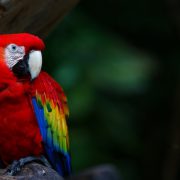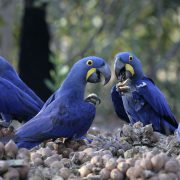Blue and Gold Macaw
The Blue and Yellow Macaw (Ara ararauna), also known as the Blue and Gold Macaw, is a large South American parrot with blue top parts and yellow under parts. It is a member of the large group of neotropical parrots known as Macaws. It inhabits forest (especially varzea, but also in open sections of terra firme or unflooded forest), woodland and savannah of tropical South America. They are popular in aviculture because of their striking color, ability to talk, ready availability in the marketplace, and close bonding to humans.
This species occurs in Venezuela, Peru, Brazil, Bolivia, and Paraguay. The range extends slightly into Central America, where it is restricted to Panama. The species’ range formerly included Trinidad, but it became extinct there by 1970 as a result of human activities. Between 1999 and 2003, wild-caught blue-and-gold macaws were translocated from Guyana to Trinidad, in an attempt to re-establish the species in a protected area around Nariva swamp. A small breeding population descended from introduced birds is found in Puerto Rico, and another has inhabited Miami-Dade County, Florida, since the mid-1980s.



 The Red and Green Macaw (Ara chloropterus), also known as the Green Winged Macaw, is a large, mostly-red macaw of the Ara genus. This is the largest of the Ara genus, widespread in the forests and woodlands of northern and central South America. However, in common with other macaws, in recent years there has been a marked decline in its numbers due to habitat loss and illegal capture for the parrot trade.
The Red and Green Macaw (Ara chloropterus), also known as the Green Winged Macaw, is a large, mostly-red macaw of the Ara genus. This is the largest of the Ara genus, widespread in the forests and woodlands of northern and central South America. However, in common with other macaws, in recent years there has been a marked decline in its numbers due to habitat loss and illegal capture for the parrot trade.

